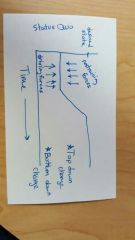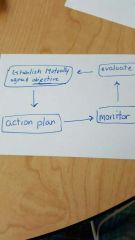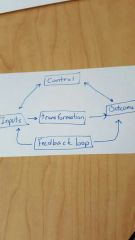![]()
![]()
![]()
Use LEFT and RIGHT arrow keys to navigate between flashcards;
Use UP and DOWN arrow keys to flip the card;
H to show hint;
A reads text to speech;
58 Cards in this Set
- Front
- Back
|
Managing Cultural Processes |
Cultural symbols Rituals and ceremony company heroes Stories Leadership Language |
|
|
Cultural symbols |
Icons and objects that communicate organizational values |
|
|
Ritual and ceremony |
Conveys organizational values Have to do it everyday |
|
|
Organizational culture |
Exposed Visible Core |
|
|
Company heroes |
Someone who embodies cultural perspectives and values |
|
|
Leadership |
Effective leaders articulate a vision that employees are excited about |
|
|
Distinguishing types of culture-type 2 |
Clubs Teams Academies Fortresses |
|
|
Importance of culture |
Competitiveness Commitment Differentiate employees Company objectives |
|
|
Teams |
Faced paced version of culture Free agent High turn over |
|
|
Clubs |
Loyal to each other Commonalities Spend life in group |
|
|
Academies |
Long term Climb ladder Different groups Specialized |
|
|
Fortresses |
Maturing business Overcome stale market Keep business going |
|
|
Types of change |
Planned Unplanned |
|
|
Forces for change |
Inside vs outside the organization |
|
|
Resistance to change |
Lack of understand and trust Self interest Uncertainty Different perspectives and goals Cultures that value tradition |
|
|
Lewins 3 step model |
Unfreeze Change Refreeze |
|
|
Force field analysis model |

|
|
|
Tactics for introducing change |
Communication and education Employee involvement Negotiation Coercion Top management support |
|
|
Planning |
Having set objectives and mapping out activities to achieve these objectives |
|
|
Key elements to a plan |
Objectives Actions Resources Implementation |
|
|
Core competencies |
Know how Skills Brand recognition Company reputation |
|
|
Benefits of planning |
Assess external forces Sense of direction Identifying factors affecting company Encourages participation Coordinates efforts Establishes priorities Focuses attention on time horizon Understand past success and failure Ensure availability of adequate resources |
|
|
Planning for what if |
Prepared for unimaginable Create alternate scenarios Elim Kaye probabilities Use internal markets Face reality |
|
|
Distinguishing types of culture- type 1 |
Traditional control vs employee involvement |
|
|
Pitfalls of planning |
Poor forecasts Plans imposed from above Planning as self contained activity Extensive burreacratization Inflexible adherence to objectives and processes |
|
|
Keys to successful planning |
Decsntralized planning process Use numerical and judgemental methods Planning os continuous Be able to adapt Avoid paralysis of analysis Concentrate on manageable set of issues |
|
|
S.M.A.R.T. |
Specific Measurable Attainable Results Time |
|
|
Keys effects of organizational culture |
Employee self management Stability Socialization |
|
|
Management by objective |

|
|
|
Strategic action plans |
Productivity Congruency Synergy |
|
|
Tactical actionable plans |
Division of labor Budgeting |
|
|
Operational action plans |

|
|
|
Implementation |
Define tasks Assign responsibilities Manage individuals |
|
|
Means of implementation |
Authority Persuasion Policy Feedback |
|
|
Process of problem solving |
Find performance gaps Identify tasks Check Congruency Create alignment Execute plan Learn from consequences |
|
|
Decision making |
Identifying problems and oppurtunities Resolve them or take advantage of them |
|
|
Characteristics of management decision making |
Programmability Uncertainty Risk Conflict Scope Crisis |
|
|
Strategic decision scope |
Long term Focus on entire organization |
|
|
Tactical decision scope |
Short term Focus on subunits of organization |
|
|
Operational decision scope |
Extremely short term Focus on routine activities |
|
|
Crisis sotuations |
Nonprogramability Uncertainty Risk |
|
|
Stages of decision making |
Identify problem Generate alternative solutions Evaluate alternatives Choose best alternatives Implement decisions Evaluate results |
|
|
Identify and diagnose the problem |
Oppurtunity -requires committing resources to improve performance Problem -when performance is below expected |
|
|
Generate alternative solutions |
Generate possible solutions based upon perceived causes |
|
|
Evaluate alternatives |
Examine alternatives based upon decision criteria Decision quality -cost, revenue, product design Decision acceptance -feelings towards the decision |
|
|
Choosing the best alternative |
Optimizing vs satisficing |
|
|
Satisficing |
Choosing the #1 best alternative |
|
|
Implement decision |
Provide resources Excercise leadership Develop communication systems |
|
|
Metamorphosis |
Their values mesh with overall organization |
|
|
Evaluate the results |
Gather info Did the implemented decision achieve its goals |
|
|
Limits of rational decision making |
Organizational politics Emotions and personal preferences Illusion of control Intuition and escalation of commitment |
|
|
Benefits of decision making in groups |
Increased acceptance Greater pool of knowledge Different perspectives Greater comprehension Training group |
|
|
Problems in decision making in groups |
Social problems Minority domination Log rolling Goal displacement "Group think" |
|
|
Leadership styles |
Decide and persuade Discover the facts and decide Consult with individuals and decide Consult with group and decide Group decision |
|
|
Questions to answer to develop strategies |
1. Where do we compete 2. Unique value? 3. Resources and capabilities? 4. Sustain our value? |
|
|
Prearrival |
What is going to happen |
|
|
Encounter |
Reality |
|
|
Tips on using organizational culture |
Strong vs weak Align vision to culture Orientation for new employees |

